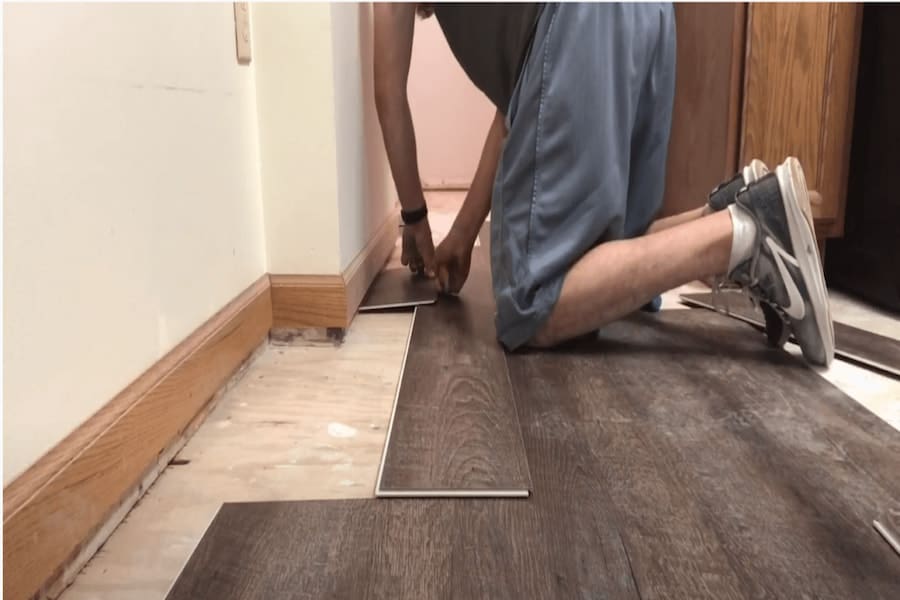Laminate flooring and no saw in sight? I’ve been there. Let’s dive into some clever methods I’ve uncovered to cut laminate seamlessly without the traditional tools. You might just be surprised at how approachable it can be!
Contents
How to Cut Laminate Flooring Without a Saw
Lets face it – using a circular saw to cut laminate flooring is a lot easier. But, its not impossible without one.
Before you start cutting the laminate floor, you need to consider the following aspects for smooth functioning and haste-free cutting.

- Measure the size and span of the room or surface. The measuring will aid you in making the right decision, like which method you should choose to cut the laminate floor.
- Most laminate flooring does not require any cutting. However, all that is needed is an average tape measure and something to celebrate with. Use a pencil or a pen to make a mark—the more precise the incisions, the finer the point. A lovely white paint marker will help you see the lines more clearly than a pencil if you’re putting a dark laminate.
- Every expert utilizes a laminate floor cutter to cut laminate floorboards to length, and it’s the key to learning how to cut a laminate floor. Instead of sawing the laminate, the knife slices it with a strong blade and a long handle that applies downward pressure. There’s no sawdust here, and there’s no noise! Your DIY mates will be begging to borrow it once you have one — they’re that handy.
Using a Utility Knife
Cutting flexible, self-adhering laminate strip material with a standard utility knife blade is possible. The caveat is that you must replace the blades regularly to ensure that the knife cuts properly; a dull blade will not cut well.
By far, the most incredible hand tool for cutting vinyl and laminate flooring is a utility knife. That can use a utility knife to cut vinyl flooring. Because of its curved blade form, the Linoleum Knife, a type of Utility Knife, is ideal for this task.
On Formica, scoring cuts can be made with a utility knife. Due to the similarity of all plastic laminates, cutting Formica with a utility knife is similar to cutting other laminates.
If the material is heated in advance using a heat gun to make it flexible enough to cut with a knife, that can also use a utility knife to help cut vinyl tile squares around corners for L-shaped and nonlinear cuts.
Using Cutters and Shears
A laminate floor cutter is a tool for cutting laminate flooring. If you need to cut laminate, let’s get started. We’ll show you how to locate the best laminate floor cutter that cuts laminate swiftly and efficiently. If you have the correct laminate floor cutter, installing laminate flooring in your home will be a breeze.
These cutters are entirely hassle-free and almost failsafe for anyone attempting to DIY their way to immaculate flooring. They’ll also provide you with the neat edges you’ll need to put the flooring together. Furthermore, using a laminate floor cutter produces less dust, which is always a plus in our eyes.
Do It Yourself
DIY work can save money when done correctly, but you’re more likely to make mistakes if you don’t have much experience. Due to errors, many homeowners have to repurchase items, resulting in a much more extended installation period.
When cutting laminate flooring with a saw, the potential of chipping the floor is a concern. Dealing with this material can be aggravating, especially if the cuts aren’t precise or straight. When determining the best way to cut laminate flooring, several things must be considered, including the final product’s mass, structure, and shape.

All you have to do with a cutter is apply force on the handle. The laminate flooring cutter creates crosscuts in the same way that a paper cutter does. To achieve the most significant results, you’ll need to follow the instructions below:
- Make a note of the crosscut’s length.
- Lay masking tape on the cut line and draw a sample on the reverse of the board.
- Feed in the plank with the grain facing up.
- Align the cutter’s blade with the drawn line.
- Slice the plank in half by pressing down on the handle.
Potential Problems
When it comes to the dangers of utilizing electric saws, it’s best to hire a professional in addition to the risk of injuring oneself; making an improper incision might easily damage the flooring.
Another issue is that laminate is a problematic material to form. Unless the tools are high-end and have hardened blades, many saws will get weaker and more hazardous during the process.
Woodworkers and other professionals who work with these materials regularly generally own hardened saws.
Contractors
Hiring a professional can be beneficial in the following ways:
- Professionals will bring their instruments and will frequently install as well as cut the flooring.
- Their job will save you money long-term because they are less prone to make mistakes.
Due to mistakes, many homeowners have to repurchase items, resulting in a much more extended installation period.
You should employ a contractor if you are unable to handle the force created by the saw. Contractors also have a lot of knowledge and can work with more challenging places, like curved rooms or stairwells, where small components fit around the borders.
According to Bob Tschudi, “The circular saw is the greatest invention ever made for the contractor.” He added, “I’ve watched talented subcontractors cut everything from heavy doors to delicate trim with a circular saw, and the results were impressive.”
Pull Bar
Every laminate flooring installation includes carefully pulling pieces of laminate together from end to end. The problem is that there isn’t enough area to strike a mallet and tapping block on the backs of laminate pieces where they contact a wall.
To remedy this problem, you’ll need a pull bar, which is a simple hook-shaped tool. It is bent on one end to contact the end of the laminate floor.
Using Multi-Tool
Most laminate flooring simply requires scoring the top layer, after which it will break neatly. If you make it that way instead of using a jigsaw, you won’t have a suitable mating surface, but a person can get away with only that.
Cut an oscillating blade using a multi-tool. It’s a beautiful tool for getting a straight line. However, it’s slower than other cutting tools. You can get along very well if you know how to use the multi-tool.
They’re all accessible with the flick of a finger using a multi-tool. When you’re out hiking, bicycling, or fishing, keep one in your pocket, and you can use it for anything.
Although multi-tools make my life easier, finding the one that is best for you can be difficult. Blades, snips, as well as other bits and bobs, come in a variety of configurations.
Rubber Mallet
Part of the installation process is persuading pieces of laminate flooring to fit together correctly, and this is where a rubber mallet may help.
Mallet blows pull laminate pieces together end-to-end when used in conjunction with a tapping block usually takes more on that in a minute. That can use a regular steel hammer to replace the rubber mallet, but the rubber is quieter.

Drill or Spade Bit
If you need to install laminate flooring surrounding pipes that run through the floor, you’ll need a 12, 18, or 20-volt drill and spade bit. This drill and bit set allows you to bore wide, clean holes in laminate parts that must surround a pipe.
When it’s time to bore openings in your laminate flooring, do it while it’s laying on scrap 1-1/2-inch thick hardwood. This method allows you to apply a lot of pressure to the bit while also holding the bottom of the laminate, so it doesn’t tear out on the bottom face where the bit departs the flooring.
Conclusion
Cutting laminate without a saw is no easy task, but its not impossible. For example, cutting laminate flooring that is already installed is even harder.
Alternative laminate cutting tools (other than a saw) have the advantage of producing no dust throughout the procedure. If you want a safe and simple tool for this type of job, the options on the list we provided will suffice.
